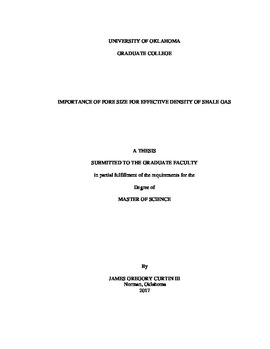| dc.description.abstract | The proper development of any natural gas reservoir depends on knowing several key factors; perhaps the most important of these factors is the volume of gas-in-place of a reservoir at a given pressure. Gas-in-place calculations determine the economic value of gas reserves and tell us whether and how they can be economically developed. Accurately determining gas-in-place and ultimate gas recovery require accurate fluid density data.
This thesis demonstrates the importance of a pore size for fluid densities in shale formations. The fluid density increase significantly for pores whose diameters are smaller than 10 nm. However, what is equally significant is the pore size distribution of the rock tested and whether that distribution represents pore-body sizes or pore-throat sizes. For two Barnett shale samples used in this thesis, it was found that the effect of pore-body size on effective gas density is insignificant at pressures consistent with formation depth when calculating gas-in-place. This conclusion is reached assuming that the pore-body size distribution, not the pore-throat size distribution, best characterizes the pore geometry when calculating gas in place
The numerical results of this theses are only valid for the samples with similar pore-body size distributions. However, they have important qualitative implications for reservoir simulation and production. Simulations that calculate gas density based on pore-throat size distribution, as opposed to pore-body size distribution, will produce higher effective gas density than the in-situ value; thus, they lead to an overly optimistic hydrocarbon in-place and ultimate recovery estimates. As the effective density is a key component for viscosity and phase behavior of petroleum resources production estimates generated by these models will also be unrealistic. | en_US |
